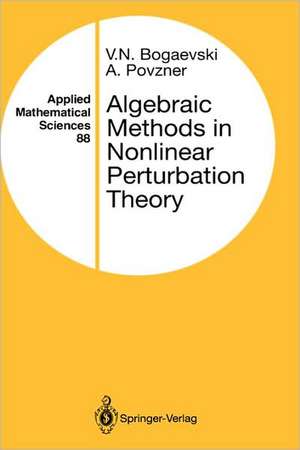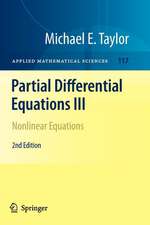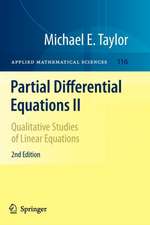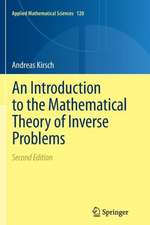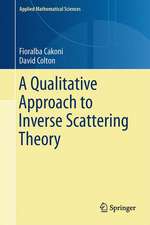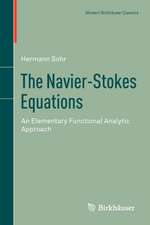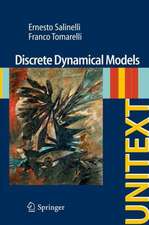Algebraic Methods in Nonlinear Perturbation Theory: Applied Mathematical Sciences, cartea 88
Autor V.N. Bogaevski, A. Povzneren Limba Engleză Hardback – 10 mai 1991
| Toate formatele și edițiile | Preț | Express |
|---|---|---|
| Paperback (1) | 639.73 lei 6-8 săpt. | |
| Springer – 19 noi 2011 | 639.73 lei 6-8 săpt. | |
| Hardback (1) | 646.11 lei 6-8 săpt. | |
| Springer – 10 mai 1991 | 646.11 lei 6-8 săpt. |
Din seria Applied Mathematical Sciences
- 13%
 Preț: 426.94 lei
Preț: 426.94 lei - 13%
 Preț: 426.46 lei
Preț: 426.46 lei - 13%
 Preț: 427.63 lei
Preț: 427.63 lei - 9%
 Preț: 1728.59 lei
Preț: 1728.59 lei - 24%
 Preț: 906.80 lei
Preț: 906.80 lei - 23%
 Preț: 659.07 lei
Preț: 659.07 lei -
 Preț: 375.65 lei
Preț: 375.65 lei - 18%
 Preț: 909.47 lei
Preț: 909.47 lei - 18%
 Preț: 795.02 lei
Preț: 795.02 lei - 18%
 Preț: 950.52 lei
Preț: 950.52 lei - 15%
 Preț: 645.47 lei
Preț: 645.47 lei - 20%
 Preț: 755.49 lei
Preț: 755.49 lei -
 Preț: 382.67 lei
Preț: 382.67 lei - 24%
 Preț: 808.06 lei
Preț: 808.06 lei -
 Preț: 452.62 lei
Preț: 452.62 lei -
 Preț: 190.23 lei
Preț: 190.23 lei -
 Preț: 399.12 lei
Preț: 399.12 lei - 18%
 Preț: 966.90 lei
Preț: 966.90 lei - 15%
 Preț: 643.48 lei
Preț: 643.48 lei - 15%
 Preț: 528.80 lei
Preț: 528.80 lei -
 Preț: 413.15 lei
Preț: 413.15 lei -
 Preț: 390.25 lei
Preț: 390.25 lei - 18%
 Preț: 736.01 lei
Preț: 736.01 lei - 18%
 Preț: 1411.05 lei
Preț: 1411.05 lei - 15%
 Preț: 711.21 lei
Preț: 711.21 lei -
 Preț: 395.47 lei
Preț: 395.47 lei - 18%
 Preț: 1017.26 lei
Preț: 1017.26 lei -
 Preț: 403.15 lei
Preț: 403.15 lei - 18%
 Preț: 1130.14 lei
Preț: 1130.14 lei - 18%
 Preț: 1134.87 lei
Preț: 1134.87 lei - 18%
 Preț: 1329.00 lei
Preț: 1329.00 lei - 18%
 Preț: 1129.65 lei
Preț: 1129.65 lei - 18%
 Preț: 1140.71 lei
Preț: 1140.71 lei
Preț: 646.11 lei
Preț vechi: 760.13 lei
-15% Nou
Puncte Express: 969
Preț estimativ în valută:
123.65€ • 134.26$ • 103.86£
123.65€ • 134.26$ • 103.86£
Carte tipărită la comandă
Livrare economică 22 aprilie-06 mai
Preluare comenzi: 021 569.72.76
Specificații
ISBN-13: 9780387974910
ISBN-10: 0387974911
Pagini: 266
Ilustrații: XII, 266 p.
Dimensiuni: 155 x 235 x 18 mm
Greutate: 0.58 kg
Ediția:1991
Editura: Springer
Colecția Springer
Seria Applied Mathematical Sciences
Locul publicării:New York, NY, United States
ISBN-10: 0387974911
Pagini: 266
Ilustrații: XII, 266 p.
Dimensiuni: 155 x 235 x 18 mm
Greutate: 0.58 kg
Ediția:1991
Editura: Springer
Colecția Springer
Seria Applied Mathematical Sciences
Locul publicării:New York, NY, United States
Public țintă
ResearchCuprins
1 Matrix Perturbation Theory.- 1.1 Perturbation Theory for a Linear Operator.- 1.2 Main Formulas.- 1.3 Diagonal Leading Operator.- 1.4 General Case. The Normal Form of the Matrix of the Operator M.- 1.5 Nilpotent Leading Operator. The Reconstruction Problem.- 2 Systems of Ordinary Differential Equations with a Small Parameter.- 2.1 Passage to the Linear Problem. Change of Variables Operator.- 2.2 General Formulation of the Perturbation Theory Problem.- 2.3 Canonical Form of First Order Operator X0.- 2.4 An Algebraic Formulation of the Perturbation Theory Problem.- 2.5 The Normal Form of an Operator with Respect to a Nilpotent X0. The Reconstruction Problem.- 2.6 A Connection with N. N. Bogolyubov’s Ideas.- 2.7 The Motion Near the Stationary Manifold.- 2.8 Hamiltonian Systems.- 3 Examples.- 3.1 Example: The Pendulum of Variable Length.- 3.2 Example: A Second Order Linear Equation.- 3.3 Example: P. L. Kapitsa’s Problem: A Pendulum Suspended from an Oscillating Point.- 3.4 Example: Van der Pol Oscillator with Small Damping.- 3.5 Example: Duffing Oscillator.- 3.6 Example: Drift of a Charged Particle in an Electromagnetic Field.- 3.7 Example: Nonlinear System: Example of an Extension of an Operator.- 3.8 Example: Nonlinear Oscillator with Small Mass and Damping.- 3.9 Example: A Nonlinear Equation; Boundary-Layer-Type Problem.- 3.10 Example: Resonances. Particular Solutions.- 3.11 Example: The Mathieu Equation.- 3.12 Example: Oscillating Spring.- 3.13 Example: Periodic Solution (Hopf’s Theorem).- 3.14 Example: Bifurcation.- 3.15 Example: Problem of a Periodic Solution of an Autonomous System.- 3.16 Example: One Problem on Eigenvalues.- 3.17 Example: A. M. Lyapunov’s Problem.- 3.18 Example: Illustration for Section 2.5.- 3.19 Example: Fast Rotation of a Solid Body.-3.20 Example: The Langer Problem ([28]).- 4 Reconstruction.- 4.1 Introduction.- 4.2 New Leading Operators in the First Type Problems.- 4.3 The Second Type Problems. “Algebraic” Method of Reconstruction.- 4.4 “Trajectory” Method of Reconstruction.- 4.5 Matching.- 4.6 Example: Illustration for 4.5.- 4.7 Example: Appearance of a New Singularity.- 4.8 Example: Passing Through a Resonance.- 4.9 Example: WKB-Type Problem.- 4.10 Example: Lighthill’s Problem [38].- 4.11 Example: Singularity of Coefficients of an Operator.- 4.12 Example: A Second Order Linear Equation.- 4.13 Example: Van der Pol Oscillator (Relaxation Oscillations).- 5 Equations in Partial Derivatives.- 5.1 Functional Derivatives.- 5.2 Equations with Partial Derivatives Whose Principal Part Is an Ordinary Differential Equation.- 5.3 Partial Derivatives. On Whitham Method.- 5.4 Geometric Optics and the Maslov Method.- 5.5 Problem (Whitham).- 5.6 Problem. Diffraction of Short Waves on a Circle (Semishade).- 5.7 One-Dimensional Shock Wave.- References.
